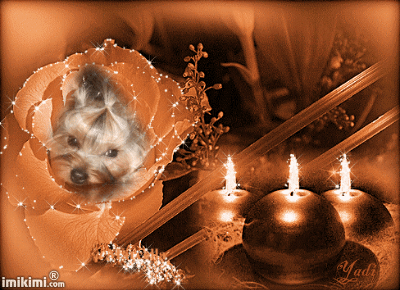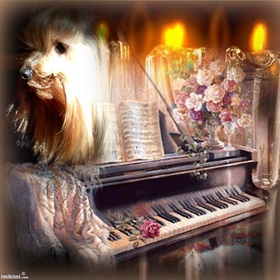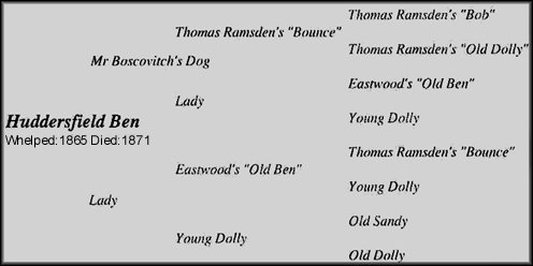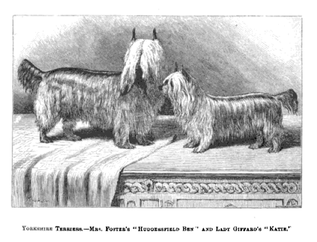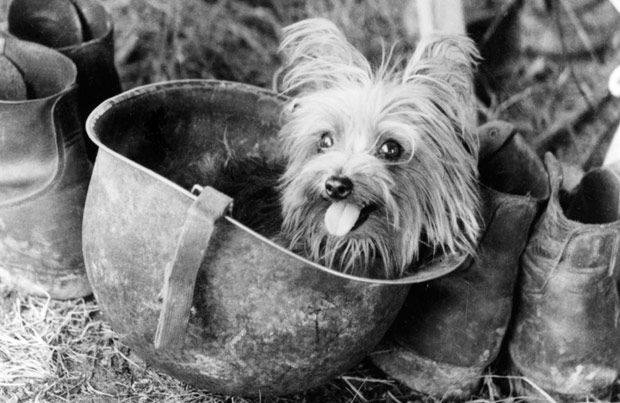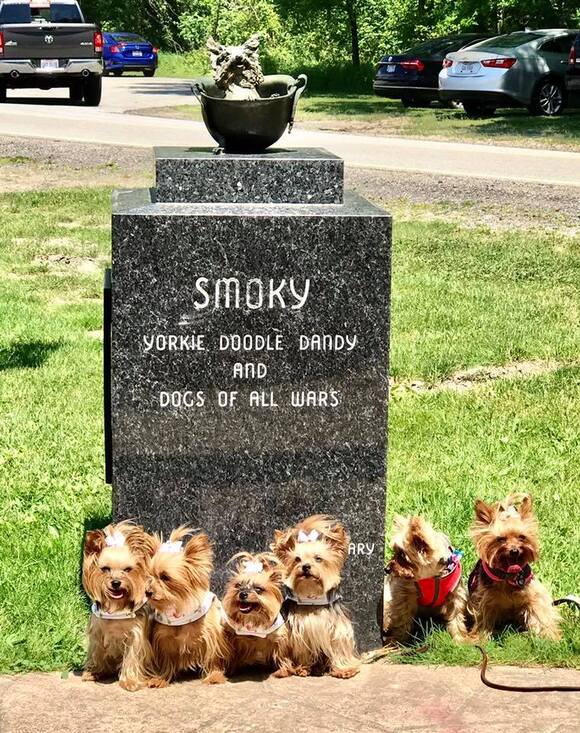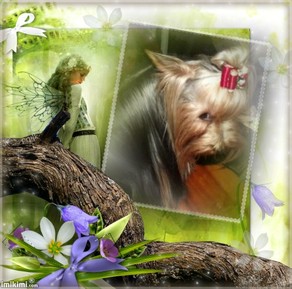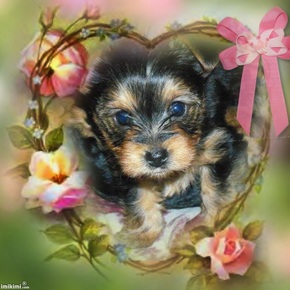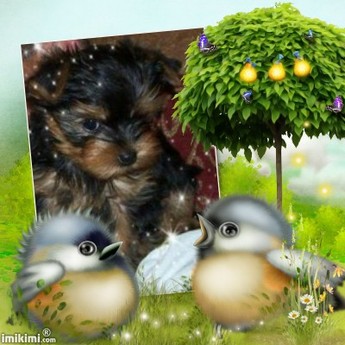The History of the Yorkshire Terrier
started with a dog called "Hudderfeild Ben"
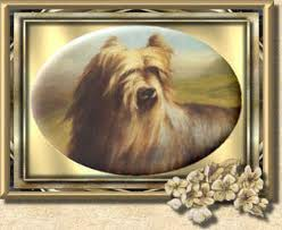
Huddersfield Ben
This is the dog that has set standards for Yorkshire Terriers and has defined the breed. He and his progeny have won numerous show awards and ratting contests and brought enormous popularity to the breed that was previously used for rat hunting.
Ben was born in 1865 in the home of Mr. W. Eastwood, a dog breeder.
His pedigree states that he was linebred – conceived in a mother – son pairing, just like his mother Lady was. That same Lady was a fourth generation descendant of Old Crab, who is, along with his mate Old Kitty the oldest recorded predecessor
to the Yorkshire Terrier breed. Ben was sold to Mr. and Mrs. M.A. Foster who lived in Bradford in West Yorkshire, and in whose ownership he gained his fame. Mrs. Foster is credited as the first woman to judge in dog shows in England,
as well as being the person who brought this level of popularity to Yorkshire Terriers. She brought Ben to Manchester shows in 1869 and 1870 where he won second and first place, respectively. He was again shown in 1870 in Crystal
Palace, where he won the first place, and the year after, also in Crystal Palace, when he was entered in multiple categories, he won the second place in Broken Haired Scotch or Yorkshire Terrier class, while the first and third place both went to his sons. During his career he earned a total of 74 prizes.
Ben was a very popular stud dog, and has fathered a great number of pups which became the foundation stock of the whole breed. Even though he weighted between 9 and 12 pounds all of his puppies competed in the up to 7 pounds class.
On the September 23rd 1871, when he was 6 years old, Ben was hit by a carriage and killed, leaving a now already famous breed without its most famous member.
Small terriers, long since vanished from the homes and hills of Scotland, are considered forbears of our delightful breed. The Waterside Terrier was developed by the mid-1700's by country folk to keep homes safe from rats and other vermin.
Small terriers, such as the now extinct Clydesdale or Paisley Terrier, the Skye Terrier, and the black and tan English Terrier, are possibly ancestors. Later called Scotch Terriers, they moved, with their Scotsmen owners, south to Yorkshire for work. Breed development continued, and the pretty blue and tan
Yorkshire Terrier, as it is known today, was finally recognised by the Kennel Council of England as a breed.
The first Yorkshire Terrier known to have been in Australia was "Punch," exported to Brisbane. from England around 1872 by Mr J Spink. "Punch", was a close relative of Huddersfield Ben. From that time the breed has made its mark in the Dog World of Australia.
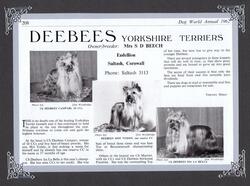 A little bit of History. Complements of Sue Murphy from CIABEN Yorkshire Terriers.
A little bit of History. Complements of Sue Murphy from CIABEN Yorkshire Terriers.
Memorial Day Remembrance: A Brave Yorkie!
Smoky was a Yorkshire terrier that was found in an abandoned foxhole, dirty and hungry, in the New Guinea jungle.
She became the companion of Corporal William Wynne in March 1944.The two spent the next 18 months together in combat. They survived 12 combat missions, 150 air raids and a typhoon.
Smoky was awarded eight battle stars. One notable feat she performed helped save the lives of some 250 men and 40 planes, thanks to her small size (only 4 pounds and 7 inches). In January 1945, a communications cable was urgently needed to run through a 70 foot long, 8 inch diameter pipe under the runway at an airbase in Luzon. The airmen tied kite string to Smoky's collar to thread the cable through the pipe. Wynne coaxed her forward, she made it through, and the communication network was established. What took the brave little pooch only minutes to accomplish would have taken the men three days to complete!
Not only was Smoky a hero, she also helped make life a little easier for the humans around her. Because of the effect she had on the emotionally and physically wounded, Smoky earned the distinction of being the first therapy dog on record. Smoky’s work as a therapy dog continued for 12 years, during and after World War II.
Honor Smoky's memory by thanking a veteran!!!
More info in link below.
https://www.thevintagenews.com/2016/09/04/smokey-yorkshire-terrier-tiniest-war-hero-first-therapy-dog/?fbclid=IwAR14QY7Cz0Vx_uXwIYR_rRqCRfzGdtdS4-_PRc_3ix6o48nfF7nmhzCMNVY
Smoky was a Yorkshire terrier that was found in an abandoned foxhole, dirty and hungry, in the New Guinea jungle.
She became the companion of Corporal William Wynne in March 1944.The two spent the next 18 months together in combat. They survived 12 combat missions, 150 air raids and a typhoon.
Smoky was awarded eight battle stars. One notable feat she performed helped save the lives of some 250 men and 40 planes, thanks to her small size (only 4 pounds and 7 inches). In January 1945, a communications cable was urgently needed to run through a 70 foot long, 8 inch diameter pipe under the runway at an airbase in Luzon. The airmen tied kite string to Smoky's collar to thread the cable through the pipe. Wynne coaxed her forward, she made it through, and the communication network was established. What took the brave little pooch only minutes to accomplish would have taken the men three days to complete!
Not only was Smoky a hero, she also helped make life a little easier for the humans around her. Because of the effect she had on the emotionally and physically wounded, Smoky earned the distinction of being the first therapy dog on record. Smoky’s work as a therapy dog continued for 12 years, during and after World War II.
Honor Smoky's memory by thanking a veteran!!!
More info in link below.
https://www.thevintagenews.com/2016/09/04/smokey-yorkshire-terrier-tiniest-war-hero-first-therapy-dog/?fbclid=IwAR14QY7Cz0Vx_uXwIYR_rRqCRfzGdtdS4-_PRc_3ix6o48nfF7nmhzCMNVY
A VERY IMPORTANT STOP in Cleveland, Ohio to see the Memorial of SMOKY the famous WWII YORKIE! Smoky only weighed 4 pounds and stood 7 inches tall. She was found by an American soldier in an abandoned foxhole in the New Guinea jungle. Another GI then sold Smoky to Corporal William A. Wynne of Cleveland, Ohio for 2 Australian pounds (about $6.44 at that time) so the seller could get back to his poker game!!! Wynne travelled with Smoky for the next 2 years, facing many adverse war conditions. Smoky was credited with 12 combat missions and awarded 8 battle stars. She survived 150 air raids and a typoon. Smoky learned many tricks and performed for the entertainment of the troops and in hospitals. Smoky died unexpectedly at the age of 14 and is buried at this very spot in a .30 caliber ammo box. There is a GREAT BOOK written about her life, called YORKIE DOODLE DANDY: A MEMOIR. We met up with our sweet FB friends, little Lola and Rubee Rose Young... so SIX YORKIES paid respect to one of our own brave war heros!
Yorkshire Terrier Characteristics
& Appearance
Appearance
A small, compact, agile, alert sturdy dog with engaging personality, spirited with dauntless courage, great intelligence, easily trainable, an admirable watchdog, fearless and tenacious, a lovable companion. This is a YORKSHIRE TERRIER!
The most outstanding feature of the Yorkshire Terrier, distinguishing him from all other small breeds, is his long, silken textured coat. It should be remembered, however, that this lustrous coat can and will look its best only with constant grooming and attention from the owner.
Temperament
Yorkies today are not bred for the sole purpose of killing rats, nor for hunting of any kind, but the breed standard was developed to preserve that vigorous attitude long after the rats were gone! So when the "ratter" is taken out of our little dog, something that was meant to be preserved forever, disappears. Yorkies slinking around with tails clamped, jumping at the slightest sound, can hardly said to be conveying an "important" air and should not be used for breeding. They don't even make good pets! Take away that "spirited and even disposition", and you don't have a true Yorkshire Terrier.
Feeding
The Yorkie has a reasonably small appetite, and a large tablespoon of food for each meal usually satisfies. Puppies and growing dogs require more food a day than the fully grown dog. Four meals a day are necessary when young.
When fully mature, one, or at the most two, meals a day are sufficient. Whatever food is given must be well balanced and wholesome.
Grooming
The true essence of the Yorkshire Terrier - that which sets it apart from other small
breeds - is it's coat.
The glossy silky coat is very similar to human hair in that it continues to grow and requires trimming. It does not shed. The coat should be brushed daily, and shampooed regularly, to maintain a healthy shiny coat.
A Yorkie in full show coat is a magnificent sight, but much care and attention is necessary to maintain a full length show coat. One of the most important points is to always ensure your Yorkie's coat is clean, and free from fleas. Scratching will break the coat and some Yorkies will chew a great lump out of the coat when they are itchy. Some also love to rub their heads and body on the carpet - this also breaks the coat. Use a flea repellant regularly.
The Yorkie's coat requires brushing every day - use a pure bristle brush, not plastic or nylon. A rolling-tooth comb is a wonderful accessory for combing out knots (available from most Pet Shops at around $8). Sit down and put your
Yorkie on your lap upside down and brush the underneath of the body as well - especially checking under the arms and neck for mats. Grass seeds can cause matting. Train your puppy to lie on its back in this manner and when they get
used to it, they do enjoy it, and it is so easy to groom.
The pet owner who has neither the time nor the inclination to give his Yorkie the necessary daily brushing would be well advised to trim the coat to a manageable length and maintain it this way. This provides a short carefree and clean coat which still requires grooming, but is much easier to manage.
Health, Care, and Development
Yorkshire Terriers are a healthy breed, with very slight incidence of inherited disorders amongst the breed in Australia.
It is important that a owners recognise that a Yorkshire Terrier is a very active dog and will expend vast amounts of energy running around jumping up and down on and off furniture, leaping much higher than it's height, therefore
putting stress on particularly it's back legs. This environmental aspect can lead to Laxating patellas - too much exercise too soon in a young dog.
Laxating patella (slipping kneecaps) can also be an inherited problem.
Teeth should always be kept clean. Various products are available for chewing, but care should be taken that small pieces do not become lodged in the throat.
Cleaning products are available – check with your Veterinarian. Failure to keep teeth clean can mean gum disease and early extraction of most teeth. Bad teeth and gum infections can also lead to heart disease.
Weight :- 3 Kg (approx) Life Span :- 13-17 Years (approx)
A small, compact, agile, alert sturdy dog with engaging personality, spirited with dauntless courage, great intelligence, easily trainable, an admirable watchdog, fearless and tenacious, a lovable companion. This is a YORKSHIRE TERRIER!
The most outstanding feature of the Yorkshire Terrier, distinguishing him from all other small breeds, is his long, silken textured coat. It should be remembered, however, that this lustrous coat can and will look its best only with constant grooming and attention from the owner.
Temperament
Yorkies today are not bred for the sole purpose of killing rats, nor for hunting of any kind, but the breed standard was developed to preserve that vigorous attitude long after the rats were gone! So when the "ratter" is taken out of our little dog, something that was meant to be preserved forever, disappears. Yorkies slinking around with tails clamped, jumping at the slightest sound, can hardly said to be conveying an "important" air and should not be used for breeding. They don't even make good pets! Take away that "spirited and even disposition", and you don't have a true Yorkshire Terrier.
Feeding
The Yorkie has a reasonably small appetite, and a large tablespoon of food for each meal usually satisfies. Puppies and growing dogs require more food a day than the fully grown dog. Four meals a day are necessary when young.
When fully mature, one, or at the most two, meals a day are sufficient. Whatever food is given must be well balanced and wholesome.
Grooming
The true essence of the Yorkshire Terrier - that which sets it apart from other small
breeds - is it's coat.
The glossy silky coat is very similar to human hair in that it continues to grow and requires trimming. It does not shed. The coat should be brushed daily, and shampooed regularly, to maintain a healthy shiny coat.
A Yorkie in full show coat is a magnificent sight, but much care and attention is necessary to maintain a full length show coat. One of the most important points is to always ensure your Yorkie's coat is clean, and free from fleas. Scratching will break the coat and some Yorkies will chew a great lump out of the coat when they are itchy. Some also love to rub their heads and body on the carpet - this also breaks the coat. Use a flea repellant regularly.
The Yorkie's coat requires brushing every day - use a pure bristle brush, not plastic or nylon. A rolling-tooth comb is a wonderful accessory for combing out knots (available from most Pet Shops at around $8). Sit down and put your
Yorkie on your lap upside down and brush the underneath of the body as well - especially checking under the arms and neck for mats. Grass seeds can cause matting. Train your puppy to lie on its back in this manner and when they get
used to it, they do enjoy it, and it is so easy to groom.
The pet owner who has neither the time nor the inclination to give his Yorkie the necessary daily brushing would be well advised to trim the coat to a manageable length and maintain it this way. This provides a short carefree and clean coat which still requires grooming, but is much easier to manage.
Health, Care, and Development
Yorkshire Terriers are a healthy breed, with very slight incidence of inherited disorders amongst the breed in Australia.
It is important that a owners recognise that a Yorkshire Terrier is a very active dog and will expend vast amounts of energy running around jumping up and down on and off furniture, leaping much higher than it's height, therefore
putting stress on particularly it's back legs. This environmental aspect can lead to Laxating patellas - too much exercise too soon in a young dog.
Laxating patella (slipping kneecaps) can also be an inherited problem.
Teeth should always be kept clean. Various products are available for chewing, but care should be taken that small pieces do not become lodged in the throat.
Cleaning products are available – check with your Veterinarian. Failure to keep teeth clean can mean gum disease and early extraction of most teeth. Bad teeth and gum infections can also lead to heart disease.
Weight :- 3 Kg (approx) Life Span :- 13-17 Years (approx)
MAKING THE RIGHT CHOICE
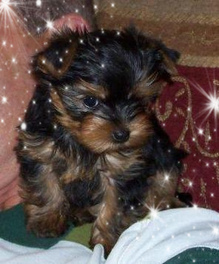
Little 'Miss Gypsy Rose;
Before making the decision to purchase a Yorkie puppy, the prospective buyer should make every effort to learn as much about the breed as possible, thus ensuring an awareness of the responsibilities that go with owning a Yorkshire Terrier. It is advisable to visit as many dog shows as are available and discuss the purchase with breeders and exhibitors. Most are only too pleased to offer any advice or information relevant to the acquisition of a puppy.
After gaining a basic awareness of the characteristics of the breed and a realisation of his own requirements, the buyer should next approach a registered breeder and state honestly and exactly the type of puppy he is interested in owning.When choosing a puppy, temperament and soundness are all important.
A puppy with a happy and fearless disposition that plays happily with his litter mates and does not shrink from the approach of strangers will give a lifetime of happiness. It should have bright sparkling eyes free from discharge, and a firm body that can be plump, but not bloated, with a glossy coat and healthy skin.
Both dog and bitch are equal in intelligence and companionship. Dogs may take a little longer to house train, and a bitch
will require extra care while in season, which generally occurs every 6-8 months. If you are not intending to breed, it is always advisable to have your bitch desexed, and your veterinarian will advise when this should be carried out.
After gaining a basic awareness of the characteristics of the breed and a realisation of his own requirements, the buyer should next approach a registered breeder and state honestly and exactly the type of puppy he is interested in owning.When choosing a puppy, temperament and soundness are all important.
A puppy with a happy and fearless disposition that plays happily with his litter mates and does not shrink from the approach of strangers will give a lifetime of happiness. It should have bright sparkling eyes free from discharge, and a firm body that can be plump, but not bloated, with a glossy coat and healthy skin.
Both dog and bitch are equal in intelligence and companionship. Dogs may take a little longer to house train, and a bitch
will require extra care while in season, which generally occurs every 6-8 months. If you are not intending to breed, it is always advisable to have your bitch desexed, and your veterinarian will advise when this should be carried out.
'THE SMART CHOICE'
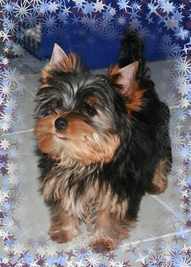
Little 'Master Grist'
A concerned breeder studies the Breed Standard set down for the Yorkshire Terrier and carefully plans a litter to maintain and improve their dogs.
Dedication to improvement of their breed should be the reason for breeding and
participating in competition in the showring. The breeder then becomes known in the Dog Community and has a reputation to protect.
The difference between a show quality puppy and the rest of the litter is very minimal and relates to such factors as perhaps the size of the ears, the colour of the pigment, size of the puppy, and so forth. It is not often possible, at a very early age, to determine what the colour of the coat of an adult Yorkshire Terrier will be, but this is also an important factor
when choosing a show ring prospect. Therefore, a breeder will often "run a puppy
for some months before the final decision as to its showability is made.
The Smart Choice to obtaining your puppy from a Registered Breeder ensures that follow-up about the care of your puppy’s every day needs is readily available – a single phone call is all that’s needed.
Dedication to improvement of their breed should be the reason for breeding and
participating in competition in the showring. The breeder then becomes known in the Dog Community and has a reputation to protect.
The difference between a show quality puppy and the rest of the litter is very minimal and relates to such factors as perhaps the size of the ears, the colour of the pigment, size of the puppy, and so forth. It is not often possible, at a very early age, to determine what the colour of the coat of an adult Yorkshire Terrier will be, but this is also an important factor
when choosing a show ring prospect. Therefore, a breeder will often "run a puppy
for some months before the final decision as to its showability is made.
The Smart Choice to obtaining your puppy from a Registered Breeder ensures that follow-up about the care of your puppy’s every day needs is readily available – a single phone call is all that’s needed.

